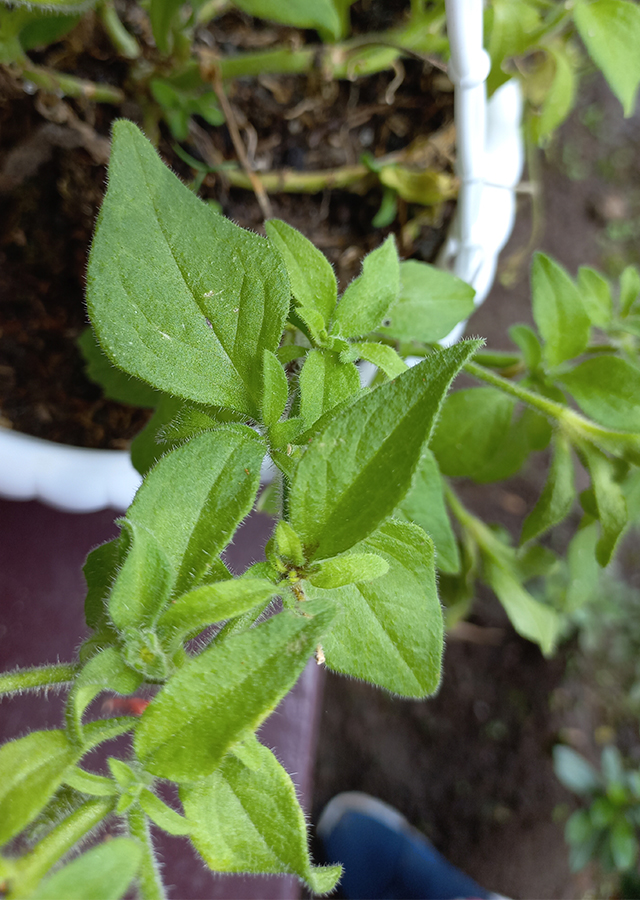Petunia
Petunia × atkinsiana (Sweet) D.Don ex W.H.Baxter
Solanaceae
Location in our garden
Principal



Synonym
Petunia x hybrida (Hook.) Regel
Habitus
Herbaceous. An annual or short-lived perennial herb, usually grows 30–80 cm high.
Part Used
Leaves
Seeds
Growing Requirements
Full Sunshine
Drought Resistant
Habitat
Roadside
Terrestrial
Overview
Petunia x atkinsiana is a plant of hybrid origin between the White Petunia (Petunia axillaris (Lamarck) Britton, Sterns & Poggenburg) and the Violet Petunia (Petunia integrifolia (Hooker) Schinz & Thellung), two species native to South America. The edible flowers are eaten locally. A very common plant in flower gardens for its showy ornamental flower.
Vernacular Names
Pétunia (French), Petunie (German).
Agroecology
Petunia can be grown as a summer annual in areas with cold winters, or as a perennial in warmer areas. Requires a sunny position. Grows and flowers best in a light, well-drained soil. Rich soils and shade encourage the plant to produce lush foliage, but at the expense of flowering. Plant in full sun to partial shade and light and well-drained soils. While it can survive in heavy shade, the blooms will suffer. This plant has moderate drought tolerance, is seldom damaged by deer and does excellent as a bedding plant and in containers. It can tolerate poor soils as long as they have good drainage.
Morphology
- Root - taproot system.
- Stem - green, branches often decumbent, glandular-hairy.
- Leaves - fragrant, opposite, alternate,broadly ovate to elliptical, 2.5–6 cm long, 1.5–4.5 cm wide, apex acute to rounded; lower leaves alternate, petiolate; upper leaves sessile, decreasing in size on flowering stems.
- Flower - fragrant, pedicels 2–4 cm long. Calyx 10–20 mm long; lobes narrowly elliptical to subfoliaceous. Corolla white, pink or purple, sometimes multicoloured; tube funnel-shaped, slightly inflated, 3–4(-6) cm long; limb rotate to broad-stellate, 4–10 cm diameter, single or double; lobes rounded. Anthers are yellow. Stamens inserted in the lower half of corolla tube, filaments 15–18 mm long; anthers 2–3 mm long. Style 25–30 mm long, erect.
- Fruit - capsule 10–15 mm long, ellipsoidal, not or shortly exceeded by calyx lobes.
- Seed - small
Cultivation
- Generative propagation is by seed - surface sow in containers, just firming the seed into the soil, and do not allow to dry out. The seed germinates best at a temperature of 15-20 °C. Prick out the seedlings when large enough to handle and plant out when 10 cm tall.
- Vegetative propagation is by softwood cuttings.
Chemical Constituents
No found data on this. Need further research.
Traditional Medicinal Uses
Used for abdominal dropsy, abdominal distention and constipation, ascariasis.
Part Used
Reference Sources
- Alabama Plant Atlas. (2022). Petunia × atkinsiana. http://floraofalabama.org/Plant.aspx?id=3541. 06-03-2022.
- CABI. (2022). Innvasive Species Compendium: Petunia. https://www.cabi.org/isc/datasheet/39844. 06-03-2022.
- Fern, Ken. (2021). Useful Tropicaal Plants:Petunia × atkinsiana. https://tropical.theferns.info/viewtropical.php?id=Petunia+%C3%97+atkinsiana. 06-03-2022.
- North Carolina Cooperative Extension. (No date). North Carolina Extension Gardener Plant Toolbox: Petunia x hybrida. https://plants.ces.ncsu.edu/plants/petunia-x-hybrida/. 06-03-2022.
- PantNet. (No date). Petunia x atkinsiana (Sweet) D.Don ex W.H.Baxter. https://plantnet.rbgsyd.nsw.gov.au/cgi-bin/NSWfl.pl?page=nswfl&lvl=sp&name=Petunia~x+atkinsiana. 06-03-2022.
- Hongkong Baptist University. 2007. Petunia hybrida (J. D. Hooker) Vilmorin. https://libproject.hkbu.edu.hk/was40/detail?channelid=1288&lang=en&searchword=herb_id=D01152. 26-01-2022.




